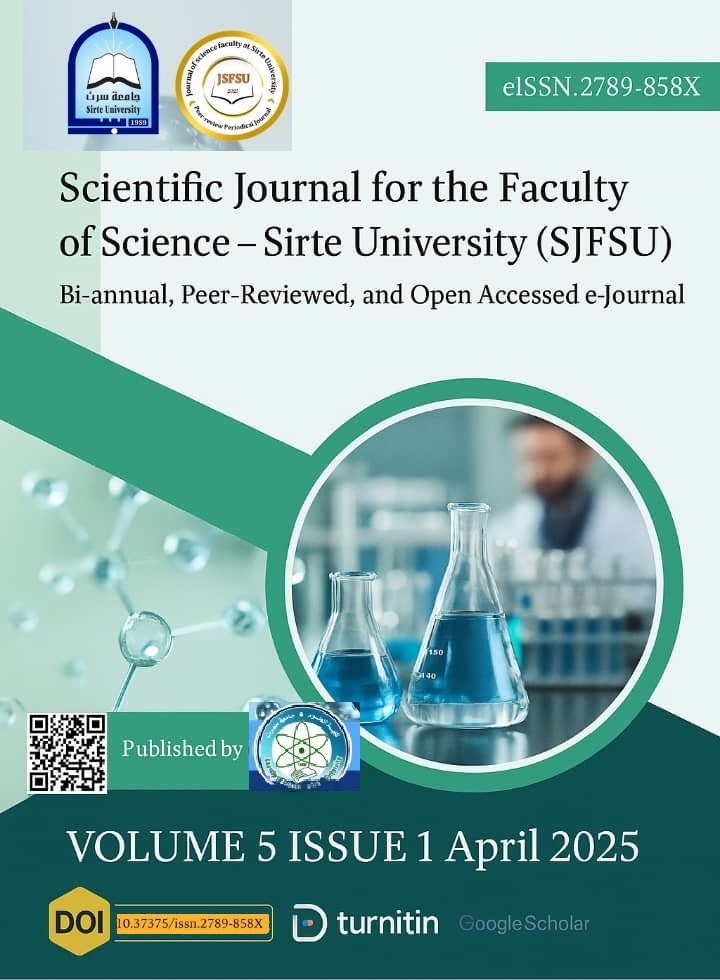Theoretical Study of the Electronic Structure of Bupivacaine and Lidocaine as Local Anesthetic Agents
DOI:
https://doi.org/10.37375/sjfssu.v5i1.2573Keywords:
Lidocaine, Bupivacaine, Theoretical calculation, DFT calculationsAbstract
Local anesthetics are widely used pharmaceuticals with numerous therapeutic effects that bind or inhibit other substances that bind to the beta2-adrenergic receptor (beta2 ARs). It was assumed there was a correlation between alkyl chain size of anesthetics and the degree of beta2 AR inhibition required. The findings of this research would utilize quantum computational methods, with special emphasis on DFT and TD-DFT, to study the structural and electronic properties of local anesthetics bupivacaine (B) and lidocaine (L). Important electronic parameters determined include ELUMO and EHOMO, dipole moment (μ), electronegativity (χ), electron affinity (A), chemical hardness (η), chemical softness(S), and ionization potential (I). All these parameters are very significant in understanding the reactivity and interaction of these molecules with biological systems.
References
Al-abbasi, A., and Shana, I. . (2021). Corrosion Inhibition of Mild Steel in Acidic Media by Expired Carbimazole Drug. Journal of Pure & Applied Sciences, 20(2), 176–180. https://doi.org/https://doi.org/10.51984/jopas.v20i2.1646
Al-abbasi, A., & Kassim, M. (2011). 1-Ethyl-1-methyl-3-(2-nitrobenzoyl)thiourea. Acta Crystallographica Section E, 67(7), o1840. https://doi.org/doi:10.1107/S1600536811024652
Al-abbasi, A., Tahir, M., Kayed, S., & Kassim, M. (2022). Synthesis, characterisation and biological activities of mixed ligand oxovanadium (IV) complexes derived from N,N-diethyl-N′-para-substituted-benzoylthiourea and hydrotris(3,5-dimethylpyrazolyl)borate [https://doi.org/10.1002/aoc.6607]. Applied Organometallic Chemistry, 36(4), e6607. https://doi.org/https://doi.org/10.1002/aoc.6607
Al-abbasi, A. A., Mohamed Tahir, M. I., & Kassim, M. B. (2012). N-(Pyrrolidin-1-ylcarbothioyl)benzamide. Acta Crystallographica Section E, 68(1), o201. https://doi.org/doi:10.1107/S1600536811053694
Al-abbasi, A. A., Yarmo, M. A., & Kassim, M. B. (2010). N-[(Piperidin-1-yl)carbothioyl]benzamide. Acta Crystallographica Section E, 66(11), o2896. https://doi.org/doi:10.1107/S160053681004170X
Al-Abbasi, A. A., Kayed, S. F., & Kassim, M. B. (2023). Spectral, theoretical, physicochemical and corrosion inhibition studies of ortho-, meta- and para-hydroxyphenyl-benzoylthiourea ligands. Inorganic Chemistry Communications, 156, 111155. https://doi.org/https://doi.org/10.1016/j.inoche.2023.111155
Almutaleb, A. A. A., & Alabbasi, A. A. (2023). Synthesis, characterization and computational studies for (2′S*,3R*,3′S*,8a′R*)-2′,3′-bis(ethoxycarbonyl)-2-oxo-2′,3′-dihydro-8a′H-spiro[indoline-3,1′-indolizine]-6′-carboxylic acid and some derivatives. Journal of Physical Organic Chemistry, 36(2), e4452. https://doi.org/https://doi.org/10.1002/poc.4452
Balakrishnan, K., Ebenezer, V., Dakir, A., Kumar, S., & Prakash, D. (2015). Bupivacaine versus lignocaine as the choice of locall anesthetic agent for impacted third molar surgery a review. Journal of Pharmacy and Bioallied Sciences, 7(Suppl 1). https://journals.lww.com/jpbs/fulltext/2015/07001/bupivacaine_versus_lignocaine_as_the_choice_of.64.aspx
Balakrishnan, K., Ebenezer, V., Kumar, A., and Prakash, D.,. (2015 ). Bupivacaine versus lignocaine as the choice of locall anesthetic agent for impacted third molar surgery a review. J Pharm Bioallied Sci., 7, S230–S233.
Becke, A. D. (1988). Density-functional exchange-energy approximation with correct asymptotic behavior. Physical Review A, 38(6), 3098. http://link.aps.org/doi/10.1103/PhysRevA.38.3098
Belkher, N., Al-abbasi, A., and Zidan, M. . (2019 ). Potentiometric Studies on Stability Constant of the Complexes of SomeEssential Transition Metal Ions with L-Valine. Journal of Pure & Applied Science 13(3), 59-63.
Chasteen, J. E. (1989). Essentials of Clinical Dental Assisting. Mosby. https://books.google.com.ly/books?id=nRtqAAAAMAAJ
Costa, J. M., & Lluch, J. M. (1984). The use of quantum mechanics calculations for the study of corrosion inhibitors. Corros Sci, 24. https://doi.org/10.1016/0010-938x(84)90113-6
Ebenso, E. E., Isabirye, D. A., & Eddy, N. O. (2010). Adsorption and quantum chemical studies on the inhibition potentials of some thiosemicarbazides for the corrosion of mild steel in acidic medium. Int J Mol Sci, 11. https://doi.org/10.3390/ijms11062473
Gece, G. (2008). The use of quantum chemical methods in corrosion inhibitor studies. Corros Sci, 50. https://doi.org/10.1016/j.corsci.2008.08.043
Hogea, B., Andor, B., Totorean, A., Hogea, L., Nussbaum, L., Bistrian, A., Sandesc, M., Folescu, R., Stanciulescu, M., Dobrin, R., Boanca, M., & Jr, P. (2018). Use of Intraoperative Analgesic and Anesthetic Substances by Intramuscular Infiltrations during Hip Surgery for Postoperative Pain Monitoring. Revista de Chimie, 69, 3530-3532. https://doi.org/10.37358/RC.18.12.6785
Jon, B., Alain, K., & Bernard, D. (1996). The generation and use of delocalized internal coordinates in geometry optimization (Vol. 105). AIP. http://dx.doi.org/doi/10.1063/1.471864
Kara, Y. S., Sagdinc, S. G., & Esme, A. (2012). Theoretical study on the relationship between the molecular structure and corrosion inhibition efficiency of long alkyl side chain acetamide and isoxazolidine derivatives [journal article]. Protection of Metals and Physical Chemistry of Surfaces, 48(6), 710-721. https://doi.org/10.1134/s2070205112060056
Khaled, K. F. (2009). Experimental and atomistic simulation studies of corrosion inhibition of copper by a new benzotriazole derivative in acid medium. Electrochimica Acta, 54(18), 4345-4352. https://doi.org/http://dx.doi.org/10.1016/j.electacta.2009.03.002
Khalifa, S., AL-abbasi, A., Suliman, M. (2018). Adsorption and Corrosion Inhibition of Mild Steel in Acidic Media by Expired Pharmaceutical Drug. Journal of Pure & Applied Sciences, 17, 1-6.
Khalil, N. (2003). Quantum chemical approach of corrosion inhibition. Electrochim Acta, 48. https://doi.org/10.1016/s0013-4686(03)00307-4
Lee, C., Yang, W., & Parr, R. G. (1988). Development of the Colle-Salvetti correlation-energy formula into a functional of the electron density. Physical Review B, 37(2), 785. http://link.aps.org/doi/10.1103/PhysRevB.37.785
Mahendra Yadav1, Sushil Kumar1, Indra Bahadur2, Deresh Ramjugernath. (2014). Corrosion Inhibitive Effect of Synthesized Thiourea Derivatives on Mild Steel in a 15% HCl Solution Int. J. Electrochem. Sci., 9, 6529 - 6550.
Martinez, S. (2003). Inhibitory mechanism of mimosa tannin using molecular modeling and substitutional adsorption isotherms. Materials Chemistry and Physics, 77(1), 97-102. https://doi.org/http://dx.doi.org/10.1016/S0254-0584(01)00569-7
Nolan, J. B., P. . (1997). Analgesia and anaesthesia
In A. S. David Skinner, Rodney Peyton & Colin Robertson (Ed.), Cambridge Textbook of Accident and Emergency Medicine (pp. 194). Cambridge University Press.
Obot, I. B., Macdonald, D. D., & Gasem, Z. M. (2015). Density functional theory (DFT) as a powerful tool for designing new organic corrosion inhibitors. Part 1: An overview. Corrosion Science, 99, 1-30. https://doi.org/http://dx.doi.org/10.1016/j.corsci.2015.01.037
Pearson, R. G. (1988). Absolute electronegativity and hardness: application to inorganic chemistry. Inorganic Chemistry, 27(4), 734-740. https://doi.org/10.1021/ic00277a030
Perdew, J. P., Burke, K., & Wang, Y. (1996). Generalized gradient approximation for the exchange-correlation hole of a many-electron system. Physical Review B, 54(23), 16533. http://link.aps.org/doi/10.1103/PhysRevB.54.16533
"Lidocaine Hydrochloride (Local)". . Retrieved Aug 26, . (2015).
Robert G. Parr , L. v. S., and Shubin Liu (1999). Electrophilicity Index J. Am. Chem. Soc., 121(9), 1922-1924.
Sastri, V. S., & Perumareddi, J. R. (1994). Selection of Corrosion Inhibitors for Use in Sour Media. CORROSION, 50(6), 432-437. https://doi.org/doi:10.5006/1.3293521
Scriabine, A. (1999). Discovery and development of major drugs currently in use. In B. A. A. S. Ralph Landau (Ed.), Pharmaceutical Innovation: Revolutionizing Human Health (pp. 211). Chemical Heritage Press.
Wazzan, N. A. (2014). DFT calculations of thiosemicarbazide, arylisothiocynates, and 1-aryl-2,5-dithiohydrazodicarbonamides as corrosion inhibitors of copper in an aqueous chloride solution. Journal of Industrial and Engineering Chemistry, 26, 291-308. https://doi.org/http://dx.doi.org/10.1016/j.jiec.2014.11.043
Yang, W., & Mortier, W. J. (1986). The use of global and local molecular parameters for the analysis of the gas-phase basicity of amines. Journal of the American Chemical Society, 108(19), 5708-5711. https://doi.org/10.1021/ja00279a008
Zarrouk, A., Hammouti, B., Dafali, A., Bouachrine, M., Zarrok, H., Boukhris, S., & Al-Deyab, S. S. (2011). A theoretical study on the inhibition efficiencies of some quinoxalines as corrosion inhibitors of copper in nitric acid. Journal of Saudi Chemical Society, 18(5), 450-455. https://doi.org/http://dx.doi.org/10.1016/j.jscs.2011.09.011

Downloads
Published
Issue
Section
License
Copyright (c) 2025 Scientific Journal for Faculty of Science-Sirte University

This work is licensed under a Creative Commons Attribution 4.0 International License.













